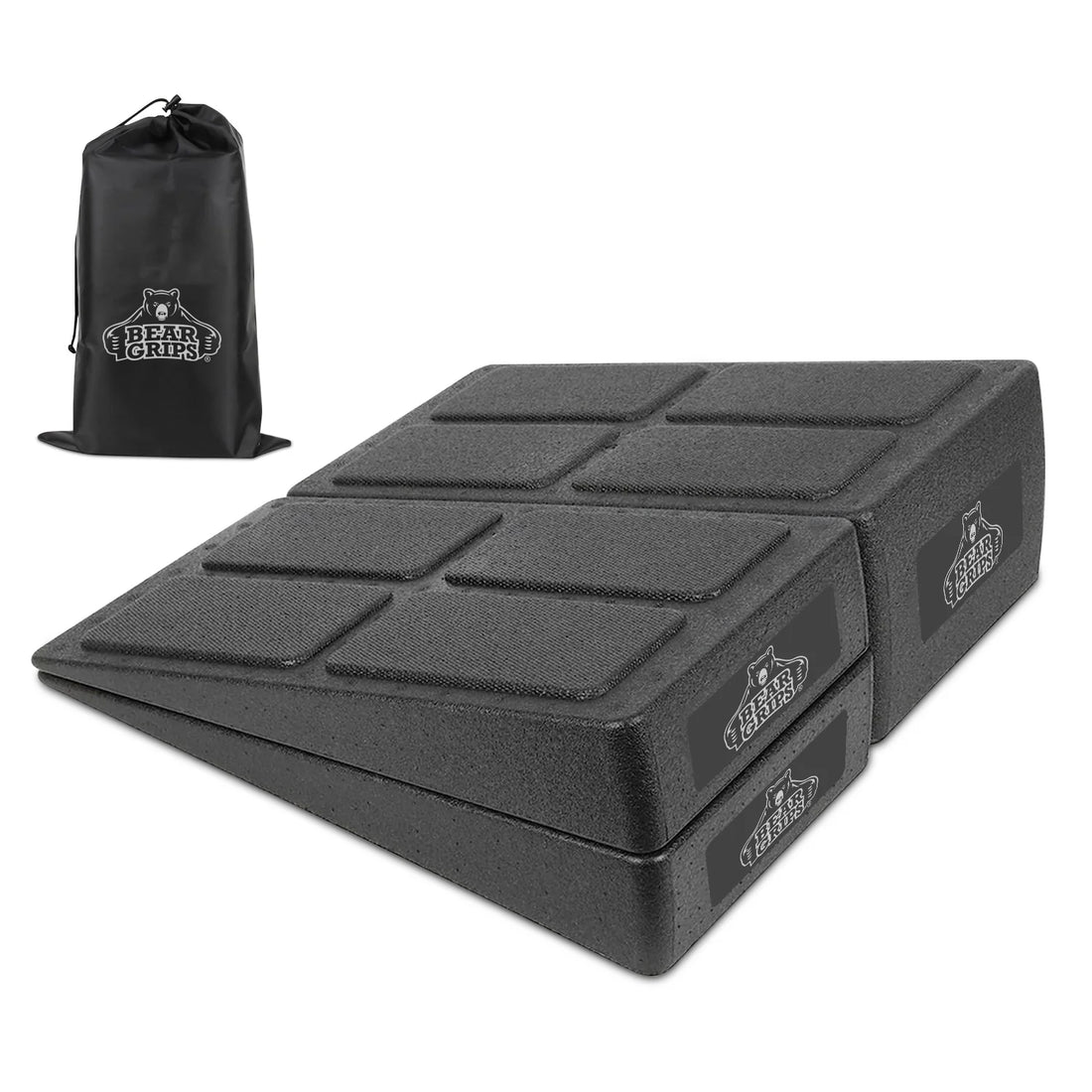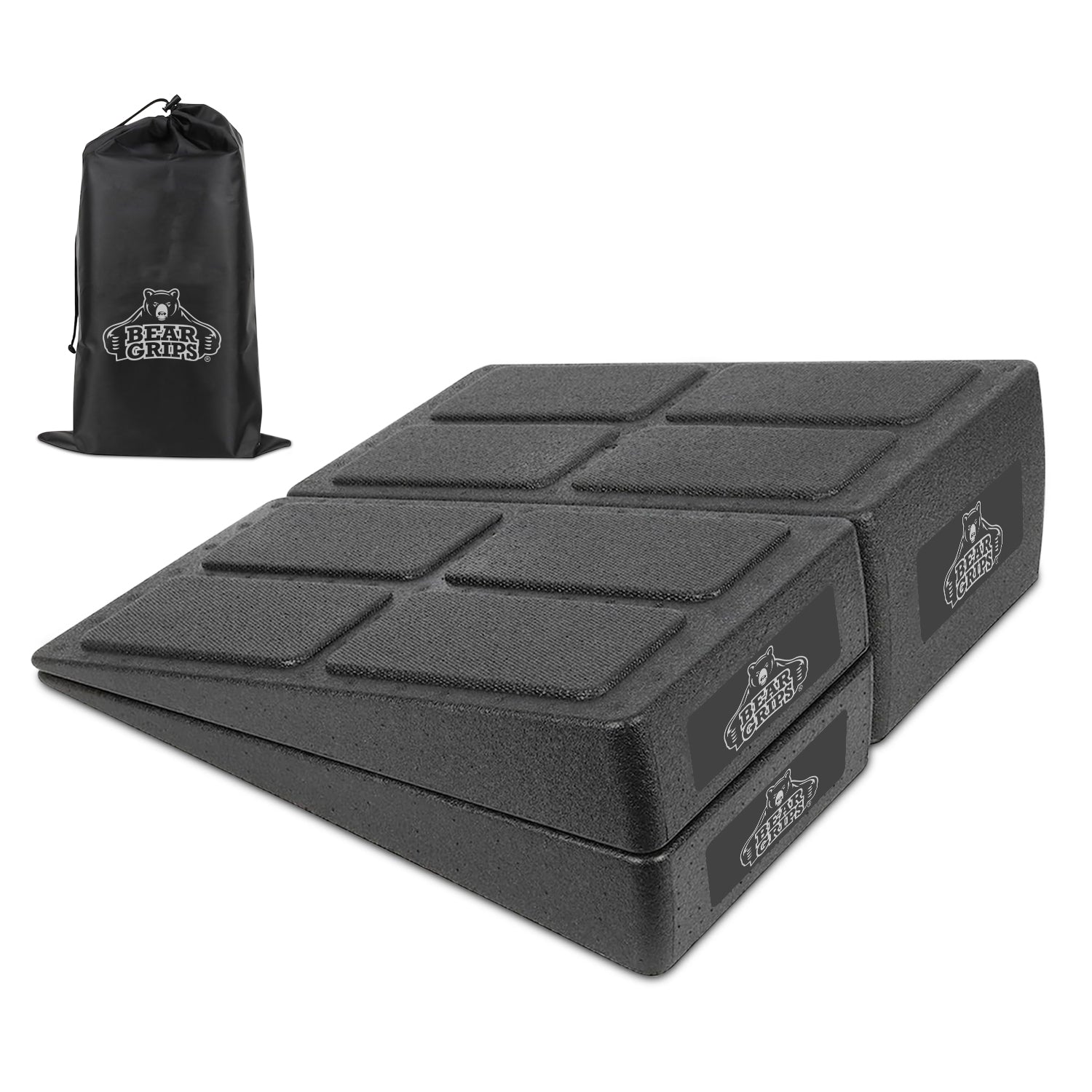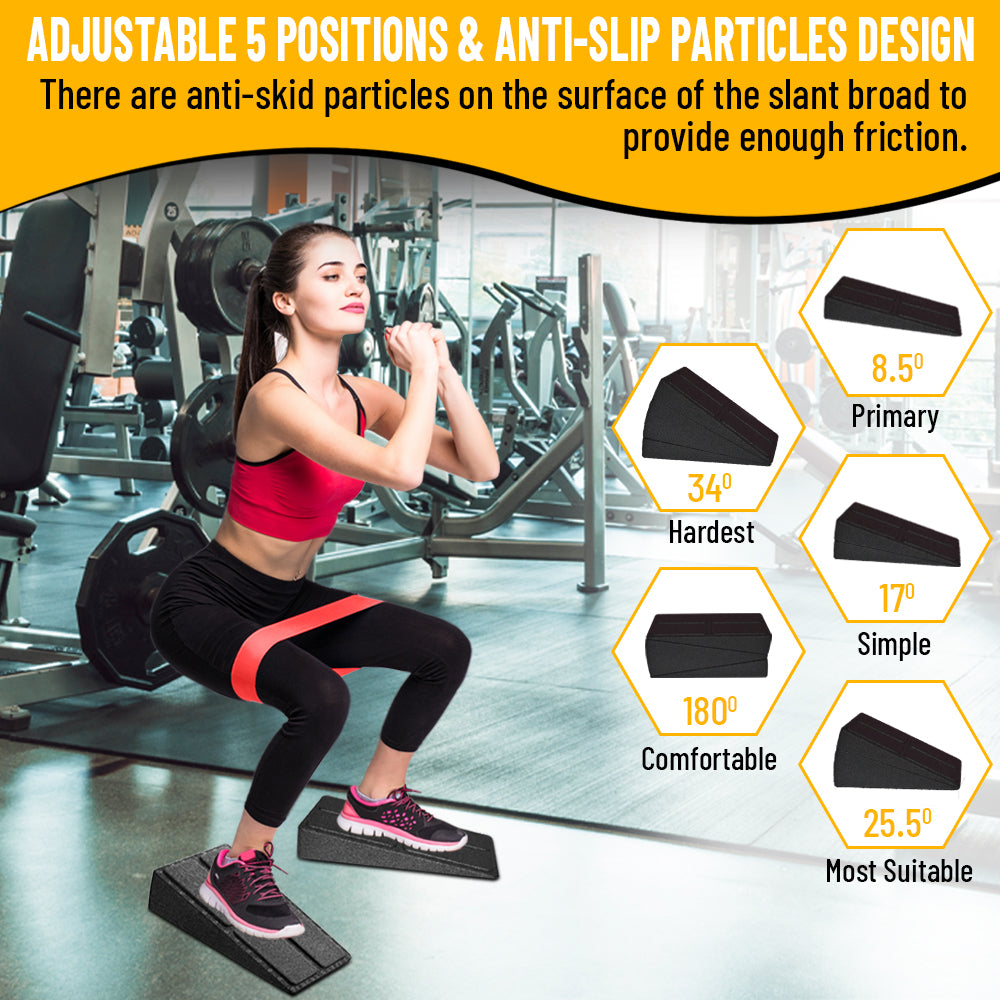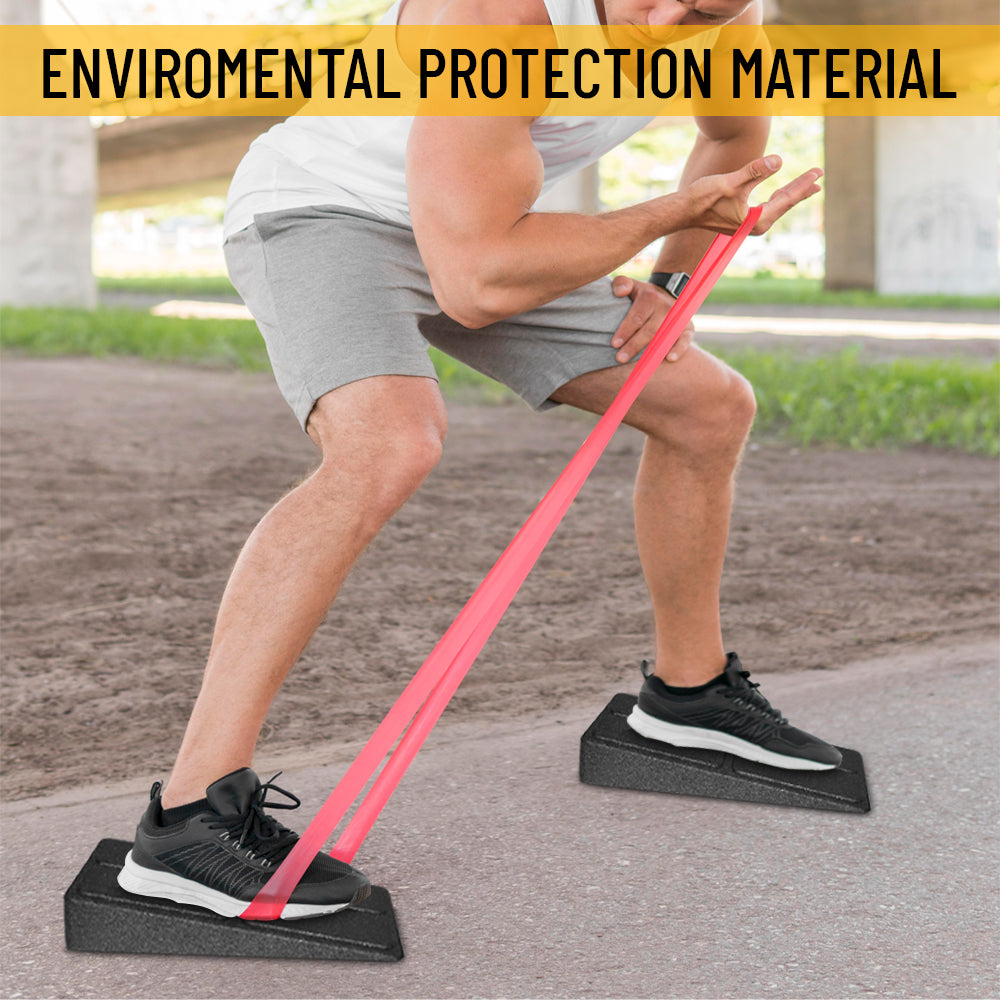
How to use squat wedge blocks?
Share
Squat wedge blocks have emerged as an innovative tool in the fitness world, revolutionizing how athletes and fitness enthusiasts approach one of the most fundamental exercises: the squat. This simple yet effective equipment is designed to enhance squatting performance, offering biomechanical advantages that were previously unattainable with traditional methods.
In this article, we delve deep into the world of squat wedge blocks, exploring their myriad benefits, the science behind their design, and practical tips for incorporating them into your workout routine. Whether you're a beginner looking to start on the right foot or an advanced lifter seeking to overcome plateaus, understanding how to use squat wedge blocks can be a game-changer in your fitness journey.

Understanding the Basics
Squat wedge blocks, often overlooked in gyms, are simple yet ingenious tools designed to elevate the heels during squats. This elevation changes the angle of the feet and ankles, offering significant benefits in terms of biomechanics, muscle engagement, and squatting depth. Here’s how they work:
- Elevated Heel Position: By raising the heel, squat wedge blocks alter the body's center of gravity, allowing for a more upright torso during squats. This reduces the strain on the lower back and focuses more on the quadriceps.
- Ankle Mobility Improvement: One common issue in squatting is limited ankle dorsiflexion. Squat wedge blocks help by reducing the demand for ankle mobility, making it easier for those with tight calves or stiff ankles to squat deeper.
- Versatility: These blocks are not just for squats. They can be used for a variety of exercises, including split squats, Bulgarian squats, and even calf raises, making them a versatile addition to any workout regimen.
Benefits of Using Squat Wedge Blocks
Squat wedge blocks are more than just a lifting accessory; they offer a range of benefits that can significantly improve your training regimen:
- Enhanced Safety: By enabling a more upright posture, they reduce the risk of lower back injuries, which are common in traditional squatting forms.
- Improved Muscle Activation: Squat wedge blocks facilitate deeper squats, which means greater muscle activation, especially in the glutes and quadriceps. This can lead to better strength gains and muscle development.
- Accessibility for All Levels: Whether you're a seasoned athlete or a fitness novice, these blocks make squats more accessible by accommodating various flexibility levels and reducing joint stress.
- Rehabilitation Tool: They are also an excellent tool for rehabilitation, helping those recovering from injuries to maintain form without putting undue stress on vulnerable areas.
- Customizable Workouts: With squat wedge blocks, you can tailor your workouts to target specific muscle groups more effectively, leading to more personalized and effective training sessions.
The Science Behind Squat Wedge Blocks
The efficacy of squat wedge blocks is rooted in biomechanics and physiology. Here’s a closer look at the science behind them:
- Biomechanical Alignment: Squat wedge blocks help in maintaining the natural curve of the spine, aligning the hips, knees, and ankles in a way that reduces shear forces on the lower back and joints. This alignment is crucial for injury prevention and long-term joint health.
- Muscle Engagement: By altering the angle of the squat, these blocks shift the focus to different muscle groups. With an elevated heel, there’s increased quadriceps engagement, while still effectively working the glutes and hamstrings.
- Ankle Dorsiflexion: Limited ankle mobility can be a significant barrier in achieving proper squat depth. Squat wedge blocks decrease the demand for ankle dorsiflexion, allowing for a deeper, more effective squat without compromising form.
- Force Distribution: The use of wedge blocks changes the distribution of force throughout the foot, which can lead to a more stable and powerful lifting position. This stability is crucial for both performance and safety.
- Adaptability: These blocks can be used to train the body to adapt to deeper squat positions over time, gradually improving flexibility and strength in the lower body.
Types of Squat Wedge Blocks
Squat wedge blocks have become an integral tool in the fitness community, offering a range of options to suit various needs and preferences. Here, we explore the diversity in these blocks, considering material variations and size and angle considerations, crucial for tailoring your workout to your specific requirements.
Material Variations
The material of squat wedge blocks plays a significant role in their durability and effectiveness. The most common materials include:
- Rubber: Offers excellent grip and stability, ideal for heavy lifting.
- Wood: A classic choice, known for its sturdiness and longevity.
- Foam: Lightweight and portable, but less durable than rubber or wood.
Each material has its unique benefits, and the choice often depends on personal preference and the type of exercise regimen.

Size and Angle Considerations
Size and angle are pivotal in determining the effectiveness of squat wedge blocks. They cater to different levels of flexibility and squatting styles.
- Size: Generally, larger blocks provide more stability, suitable for beginners or those with balance issues.
- Angle: Varies typically between 5 to 30 degrees. A steeper angle assists those with limited ankle mobility, while a lesser angle is for more advanced users.
Selecting the right combination of size and angle is crucial for maximizing the benefits of squat wedge blocks.
Setting Up Your Squat Wedge Blocks
Proper setup of squat wedge blocks is essential for a safe and effective workout. Here’s how to ensure optimal placement and adhere to safety precautions.
Placement for Optimal Use
The positioning of the blocks is as important as the exercise itself. To set up your squat wedge blocks:
- Place the blocks shoulder-width apart or slightly wider, depending on your squat stance.
- Align the blocks so that they are parallel to each other, ensuring stability.
- Test the placement by doing a few light squats to adjust the blocks as needed for comfort and balance.
Safety Precautions
Safety is paramount when using squat wedge blocks. Keep in mind:
- Ensure stability: Before starting, check that the blocks are on a flat, non-slip surface.
- Start with light weights: Get used to the new angle and positioning before increasing the weight.
- Listen to your body: If you feel any discomfort or imbalance, adjust the blocks or consult a fitness professional.
Basic Techniques for Using Squat Wedge Blocks
Mastering the basic techniques of using squat wedge blocks is crucial for anyone looking to enhance their squatting form and depth.
Proper Foot Positioning
Foot positioning on the blocks is critical for an effective squat. Your feet should be:
- Flat on the blocks: This ensures maximum stability and force distribution.
- Shoulder-width apart: Or slightly wider, depending on your natural squat stance.
- Toes slightly pointed outwards: This helps in engaging the right muscle groups.
Maintaining Balance and Form
Balance and form are the cornerstones of a successful squat. Here’s how to maintain them:
- Keep your chest up and core engaged: This helps maintain a neutral spine.
- Push through your heels: It enhances stability and power.
- Avoid leaning too far forward: This can put undue stress on your back.
By focusing on these fundamental aspects, you can maximize the benefits of using squat wedge blocks, improving your squatting technique, and reducing the risk of injury.
Advanced Squat Techniques with Wedge Blocks
Taking your squat game to the next level requires incorporating advanced techniques with squat wedge blocks. These techniques not only enhance muscle engagement but also bring variety and challenge to your workout.
Incorporating Variations
Variations in squatting with wedge blocks can significantly impact your strength and flexibility. Some advanced variations include:
- Overhead Squats: Holding a weight overhead while squatting deep on the blocks. This increases core engagement and improves posture.
- One-legged Squats: Performing squats on one leg on the block challenges balance and targets more stabilizing muscles.
Enhancing Depth and Stability
Using wedge blocks can help in achieving deeper squats safely:
- Gradually Increase Depth: Start with a comfortable range and gradually go deeper with each session.
- Focus on Stability: Engage your core and glutes to maintain stability throughout the squat.
Common Mistakes and How to Avoid Them
Even with advanced techniques, it’s crucial to be aware of common mistakes to ensure safety and effectiveness.
Overreliance on Blocks
Relying too much on wedge blocks can hinder your ability to perform squats without them. To avoid this:
- Mix It Up: Alternate between using wedge blocks and regular floor squats.
- Focus on Form: Even with blocks, ensure your form is correct to build strength and balance that translates beyond the blocks.
Incorrect Foot Placement
Foot placement is key in any squat variation:
- Regular Checks: Periodically check your foot position to ensure it’s optimal.
- Consult a Trainer: If unsure, get guidance from a fitness professional to correct your stance.
Squat Wedge Blocks for Different Fitness Levels
Squat wedge blocks are versatile and can be used by individuals at any fitness level, from beginners to advanced lifters.
Beginners’ Guide
For those new to squatting or using wedge blocks:
- Start with Basic Squats: Master the basic squat form on the blocks before trying advanced techniques.
- Focus on Comfort: Choose a block angle and size that feels comfortable and gradually progress.
Recommendations for Advanced Lifters
For the seasoned lifters looking to challenge themselves:
- Experiment with Angles and Heights: Use different angles and heights to target different muscle groups.
- Incorporate Complex Variations: Try more complex variations like paused squats or jump squats on the blocks.
By understanding and applying these advanced techniques, variations, and safety measures, both beginners and advanced lifters can effectively use squat wedge blocks to enhance their workout, avoid common pitfalls, and achieve their fitness goals.

Incorporating Squat Wedge Blocks into Your Workout Routine
Effectively incorporating squat wedge blocks into your workout routine is essential for reaping their full benefits. It's not just about using them; it's about integrating them in a way that complements and enhances your overall fitness regime.
Creating a Balanced Program
A balanced workout program with squat wedge blocks should:
- Include a Variety of Exercises: Along with squats, incorporate other strength, flexibility, and cardio exercises for a well-rounded routine.
- Address All Muscle Groups: Ensure that your workout plan targets all major muscle groups for overall fitness and avoids muscle imbalances.
Frequency and Duration
- Start Gradually: Begin by using the blocks a couple of times a week and gradually increase the frequency.
- Duration of Use: Initially, use the blocks for a short duration, focusing on form and technique before increasing the time.
Comparing Squat Wedge Blocks with Traditional Squatting
Understanding the differences between squatting with wedge blocks and traditional squatting methods is vital for knowing when and how to use each technique effectively.
Pros and Cons
- Pros of Wedge Blocks:
- Enhanced depth in squats.
- Reduced strain on knees and ankles.
- Improved balance and posture.
- Cons of Wedge Blocks:
- Potential overreliance leading to decreased versatility in squatting without them.
- May not be suitable for all types of squat variations.
When to Use Wedge Blocks
- Limited Ankle Mobility: Ideal for those with restricted ankle flexibility.
- Beginners: Useful for newcomers to build strength and confidence in squatting.
- Targeting Specific Muscles: When looking to engage particular muscles more intensely.
Squat Wedge Blocks for Rehabilitation and Injury Prevention
Squat wedge blocks can play a significant role in rehabilitation and injury prevention, especially for athletes and individuals recovering from lower body injuries.
Role in Physical Therapy
- Gradual Muscle Strengthening: They allow for a gradual increase in squat depth and intensity.
- Controlled Range of Motion: Helpful in managing and adjusting the range of motion during recovery.
Precautions for Injured Athletes
- Consult Healthcare Professionals: Before using wedge blocks, get clearance and advice from a physical therapist or doctor.
- Listen to Your Body: Avoid pushing through pain and focus on gradual progress.
Measuring Progress with Squat Wedge Blocks
Tracking your progress while using squat wedge blocks helps in setting realistic goals and understanding the effectiveness of your workout regimen.
Tracking Strength and Flexibility
- Monitor Squat Depth and Comfort: Regularly check how deep you can squat comfortably.
- Strength Gains: Keep track of the weight you can squat over time.
Setting Realistic Goals
- Incremental Objectives: Set small, achievable goals to steadily improve your performance.
- Balance Aspirations and Safety: While it’s good to challenge yourself, always prioritize safety and proper form.
Incorporating squat wedge blocks into your workout routine, understanding their pros and cons, and using them for rehabilitation and injury prevention can lead to significant improvements in your squatting technique, strength, flexibility, and overall fitness. Measuring progress and setting realistic goals will help you stay motivated and achieve your fitness aspirations.
Squat Wedge Blocks for Specific Sports Training
Squat wedge blocks are not just a tool for general fitness enthusiasts; they have specific applications in various sports, offering tailored benefits to athletes.
Application in Different Sports
- Weightlifting and Powerlifting: Enhances squat depth and strength, crucial for these sports.
- Running and Cycling: Improves lower body strength and flexibility, benefiting endurance athletes.
- Basketball and Football: Assists in building explosive power and agility.
Tailoring the Use to Specific Needs
- Customize Angle and Height: Depending on the sport, adjust the block’s angle and height for targeted muscle training.
- Sport-Specific Squats: Incorporate variations that mimic the movements and demands of the specific sport.
Maintaining and Caring for Your Squat Wedge Blocks
To ensure your squat wedge blocks remain effective and durable, proper maintenance is key.
Cleaning and Storage
- Regular Cleaning: Wipe down the blocks after each use to prevent the buildup of sweat and dirt.
- Proper Storage: Store them in a cool, dry place away from direct sunlight to prevent material degradation.
Longevity Tips
- Avoid Overloading: Use weights within the recommended capacity of the blocks.
- Periodic Inspections: Regularly check for any signs of wear and tear.
How to Use Squat Wedge Blocks
Effectively using squat wedge blocks requires understanding the correct techniques and practices.
Step-by-Step Guide
- Place the Blocks: Set them up at a comfortable width and angle.
- Position Your Feet: Stand on the blocks with feet shoulder-width apart.
- Squat Down: Keeping your back straight and chest up, squat down to the desired depth.
- Rise Up: Push through your heels to return to the starting position.
Tips for Efficiency and Effectiveness
- Start with Lighter Weights: Focus on form before increasing the load.
- Use a Mirror: Monitor your form and make adjustments as needed.

Conclusion
Squat wedge blocks are a versatile and effective tool for enhancing squatting performance, applicable in various fitness regimes and sports. Their ability to tailor to specific needs, improve technique, and assist in injury recovery makes them an invaluable asset in strength training.
As awareness of their benefits grows, squat wedge blocks are likely to become a staple in both fitness enthusiasts' and athletes' training regimes, continuing to evolve with advancements in sports science and training methodologies.
Shop At Amazon.com Now!

